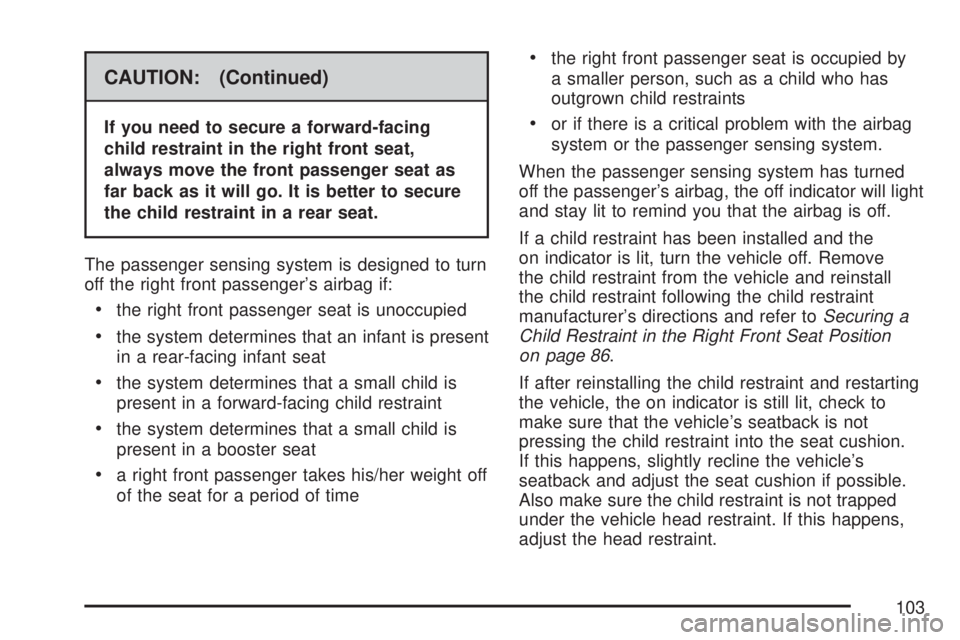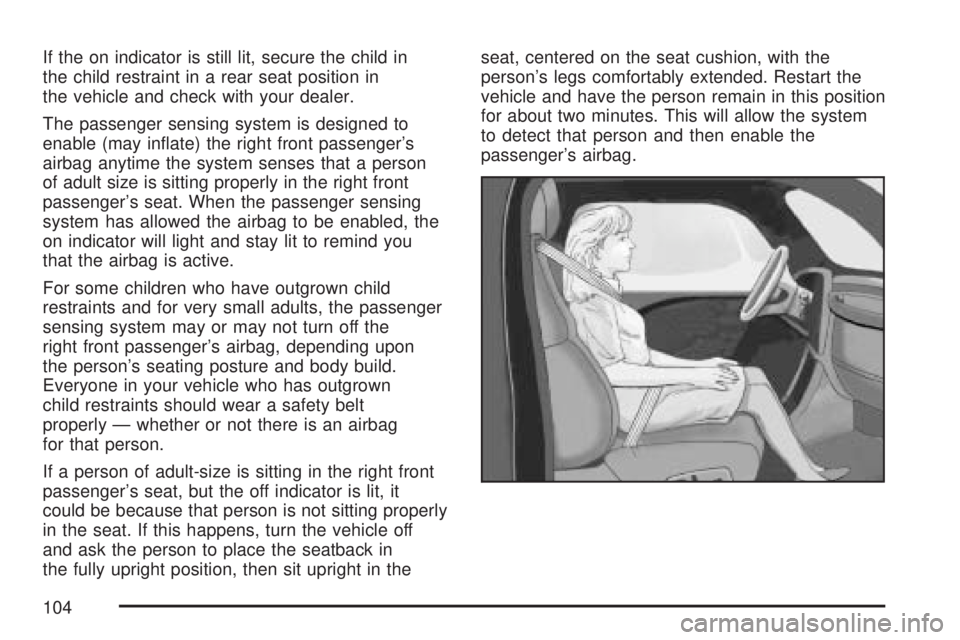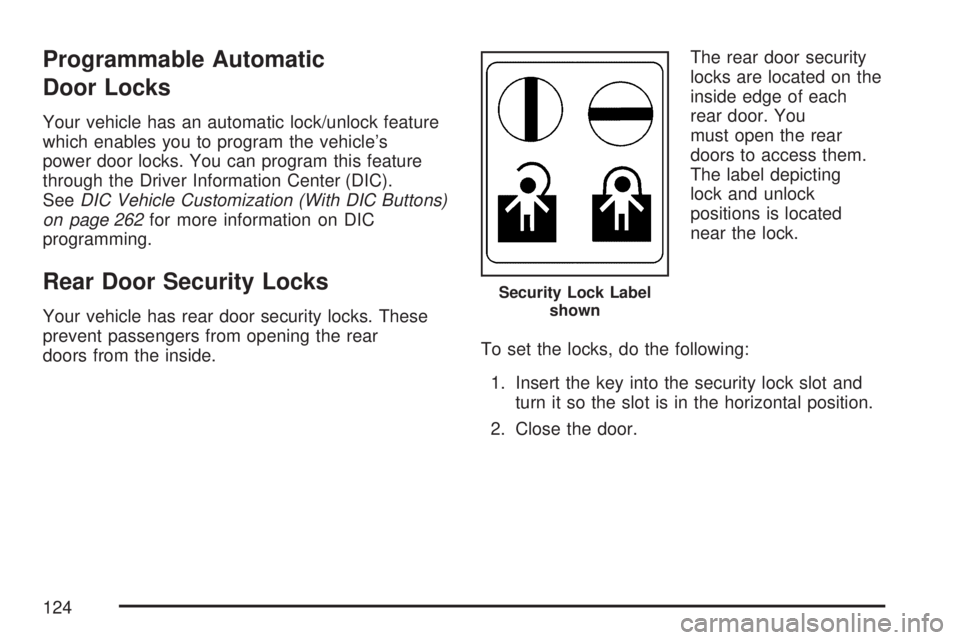2007 GMC YUKON XL DENALI ECU
[x] Cancel search: ECUPage 95 of 608

If your vehicle has a third row seat, the
roof-mounted rollover airbag is located in the
ceiling above the rear windows for the outside
passenger positions.
{CAUTION:
If something is between an occupant and
an airbag, the bag might not in�ate
properly or it might force the object into
that person causing severe injury or even
death. The path of an in�ating airbag
must be kept clear. Do not put anything
between an occupant and an airbag, and
do not attach or put anything on the
steering wheel hub or on or near any
other airbag covering. And, if your vehicle
has roof-mounted rollover airbags, never
secure anything to the roof of your
vehicle by routing the rope or tie down
through any door or window opening. If
you do, the path of an in�ating side
impact airbag will be blocked. The path of
an in�ating airbag must be kept clear.
95
Page 102 of 608

The passenger sensing system works with
sensors that are part of the right front passenger’s
seat and safety belt. The sensors are designed
to detect the presence of a properly-seated
occupant and determine if the passenger’s airbag
should be enabled (may in�ate) or not.
Accident statistics show that children are safer if
they are restrained in the rear rather than the front
seat. We recommend that child restraints be
secured in a rear seat, including an infant riding
in a rear-facing infant seat, a child riding in a
forward-facing child seat, and an older child riding
in a booster seat.
Your vehicle has a rear seat that will accommodate
a rear-facing child restraint. A label on your sun
visor says, “Never put a rear-facing child seat
in the front.” This is because the risk to the
rear-facing child is so great, if the airbag deploys.
{CAUTION:
A child in a rear-facing child restraint can
be seriously injured or killed if the right
front passenger’s airbag in�ates. This is
because the back of the rear-facing child
restraint would be very close to the
in�ating airbag. Be sure the airbag is off
before using a rear-facing child restraint
in the passenger’s position.
Even though the passenger sensing
system is designed to turn off the
passenger’s frontal airbag if the system
detects a rear-facing child restraint, no
system is fail-safe, and no one can
guarantee that an airbag will not deploy
under some unusual circumstance, even
though it is turned off. We recommend
that rear-facing child restraints be secured
in the rear seat, even if the airbag is off.
CAUTION: (Continued)
102
Page 103 of 608

CAUTION: (Continued)
If you need to secure a forward-facing
child restraint in the right front seat,
always move the front passenger seat as
far back as it will go. It is better to secure
the child restraint in a rear seat.
The passenger sensing system is designed to turn
off the right front passenger’s airbag if:
the right front passenger seat is unoccupied
the system determines that an infant is present
in a rear-facing infant seat
the system determines that a small child is
present in a forward-facing child restraint
the system determines that a small child is
present in a booster seat
a right front passenger takes his/her weight off
of the seat for a period of time
the right front passenger seat is occupied by
a smaller person, such as a child who has
outgrown child restraints
or if there is a critical problem with the airbag
system or the passenger sensing system.
When the passenger sensing system has turned
off the passenger’s airbag, the off indicator will light
and stay lit to remind you that the airbag is off.
If a child restraint has been installed and the
on indicator is lit, turn the vehicle off. Remove
the child restraint from the vehicle and reinstall
the child restraint following the child restraint
manufacturer’s directions and refer toSecuring a
Child Restraint in the Right Front Seat Position
on page 86.
If after reinstalling the child restraint and restarting
the vehicle, the on indicator is still lit, check to
make sure that the vehicle’s seatback is not
pressing the child restraint into the seat cushion.
If this happens, slightly recline the vehicle’s
seatback and adjust the seat cushion if possible.
Also make sure the child restraint is not trapped
under the vehicle head restraint. If this happens,
adjust the head restraint.
103
Page 104 of 608

If the on indicator is still lit, secure the child in
the child restraint in a rear seat position in
the vehicle and check with your dealer.
The passenger sensing system is designed to
enable (may in�ate) the right front passenger’s
airbag anytime the system senses that a person
of adult size is sitting properly in the right front
passenger’s seat. When the passenger sensing
system has allowed the airbag to be enabled, the
on indicator will light and stay lit to remind you
that the airbag is active.
For some children who have outgrown child
restraints and for very small adults, the passenger
sensing system may or may not turn off the
right front passenger’s airbag, depending upon
the person’s seating posture and body build.
Everyone in your vehicle who has outgrown
child restraints should wear a safety belt
properly — whether or not there is an airbag
for that person.
If a person of adult-size is sitting in the right front
passenger’s seat, but the off indicator is lit, it
could be because that person is not sitting properly
in the seat. If this happens, turn the vehicle off
and ask the person to place the seatback in
the fully upright position, then sit upright in theseat, centered on the seat cushion, with the
person’s legs comfortably extended. Restart the
vehicle and have the person remain in this position
for about two minutes. This will allow the system
to detect that person and then enable the
passenger’s airbag.
104
Page 107 of 608

Adding Equipment to Your
Airbag-Equipped Vehicle
Q:Is there anything I might add to the front
or sides of the vehicle that could keep the
airbags from working properly?
A:Yes. If you add things that change your
vehicle’s frame, bumper system, height,
front end or side sheet metal, they may keep
the airbag system from working properly.
Also, the airbag system may not work properly
if you relocate any of the airbag sensors. If
you have any questions about this, you should
contact Customer Assistance before you
modify your vehicle. The phone numbers and
addresses for Customer Assistance are in
Step Two of the Customer Satisfaction
Procedure in this manual. SeeCustomer
Satisfaction Procedure on page 570.
Q:Because I have a disability, I have to get
my vehicle modi�ed. How can I �nd out
whether this will affect my airbag system?
A:Changing or moving any parts of the
front seats, safety belts, the airbag sensing
and diagnostic module, rollover sensor
module, instrument panel, steering wheel,
ceiling headliner, ceiling and pillar garnish trim,
roof-mounted rollover airbag modules, or
airbag wiring can affect the operation of the
airbag system. If you have questions, call
Customer Assistance. The phone numbers
and addresses for Customer Assistance are
in Step Two of the Customer Satisfaction
Procedure in this manual. SeeCustomer
Satisfaction Procedure on page 570.
107
Page 111 of 608

Keys............................................................ 113
Remote Keyless Entry System.................. 114
Remote Keyless Entry System Operation ... 116
Doors and Locks........................................ 122
Door Locks................................................ 122
Power Door Locks..................................... 123
Delayed Locking........................................ 123
Programmable Automatic Door Locks........ 124
Rear Door Security Locks......................... 124
Lockout Protection..................................... 125
Liftgate/Liftglass......................................... 126
Power Liftgate........................................... 128
Power Running Boards.............................. 132
Windows...................................................... 132
Power Windows........................................ 133
Sun Visors................................................ 134
Theft-Deterrent Systems............................. 134
Content Theft-Deterrent............................. 135
PASS-Key
®III+......................................... 136
PASS-Key®III+ Operation......................... 137Starting and Operating Your Vehicle......... 139
New Vehicle Break-In................................ 139
Ignition Positions....................................... 140
Retained Accessory Power (RAP)............. 141
Starting the Engine.................................... 141
Adjustable Throttle and Brake Pedal.......... 143
Engine Coolant Heater.............................. 144
Automatic Transmission Operation............. 145
Tow/Haul Mode......................................... 150
Parking Brake........................................... 152
Shifting Into Park (P)................................. 153
Shifting Out of Park (P)............................. 154
Parking Over Things That Burn................. 155
Engine Exhaust......................................... 156
Running the Engine While Parked............. 157
Mirrors......................................................... 158
Automatic Dimming Rearview Mirror with
OnStar
®, Compass and Temperature
Display................................................... 158
Outside Power Foldaway Mirrors............... 161
Section 2 Features and Controls
111
Page 124 of 608

Programmable Automatic
Door Locks
Your vehicle has an automatic lock/unlock feature
which enables you to program the vehicle’s
power door locks. You can program this feature
through the Driver Information Center (DIC).
SeeDIC Vehicle Customization (With DIC Buttons)
on page 262for more information on DIC
programming.
Rear Door Security Locks
Your vehicle has rear door security locks. These
prevent passengers from opening the rear
doors from the inside.The rear door security
locks are located on the
inside edge of each
rear door. You
must open the rear
doors to access them.
The label depicting
lock and unlock
positions is located
near the lock.
To set the locks, do the following:
1. Insert the key into the security lock slot and
turn it so the slot is in the horizontal position.
2. Close the door.
Security Lock Label
shown
124
Page 125 of 608

When you want to open a rear door when the
security lock is on, do the following:
1. Unlock the door using the remote keyless
entry transmitter, if the vehicle has one, the
power door lock switch, or by lifting the
rear door manual lock.
2. Open the door from the outside.
To cancel the rear door security lock, do the
following:
1. Unlock the door and open it from the outside.
2. Insert the key into the security lock slot
and turn it so the slot is in the vertical position.Lockout Protection
This feature protects you from locking the key in
the vehicle when the key is in the ignition and
a front door is open.
If the driver’s side power door lock switch is
pressed when the driver’s door is open and the
key is in the ignition, all of the doors will lock and
then the driver’s door will unlock.
If the passenger’s side power door lock switch is
pressed when the front passenger’s door is open
and the key is in the ignition, all of the doors will
lock and then the front passenger’s door will unlock.
125